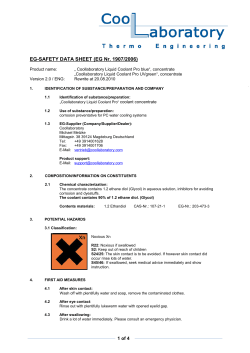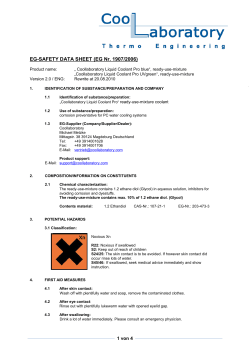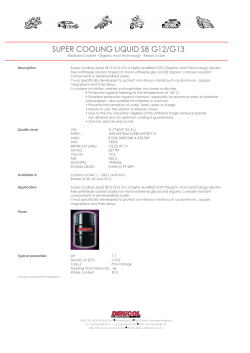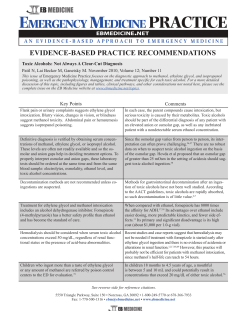
Module: 3 Lecture: 19 PROPYLENE GLYCOL
Module:3 Lecture:19 Propylene glycol Dr. N. K. Patel Module: 3 Lecture: 19 PROPYLENE GLYCOL INTRODUCTION Propylene glycol, C3H8O2 or HO-CH2-CHOH-CH3, also called as 1,2propanediol or propane-1,2-diol is colourless, odourless an organic compound. It is a clear, viscous liquid with a faintly sweet taste, hygroscopic and miscible with water, acetone, and chloroform. The compound is sometimes called α-propylene glycol to distinguish it from the isomer propane-1,3-diol HO-(CH2)3-OH, also called β-propylene glycol. The propylene glycol family of chemical compound consists of monopropylene glycol (PG), dipropylene glycol (DPG) and tripropylene glycol (TPG). DPG and TPG have several structure and stereochemical isomers. This chemicals finds number of applications. Generally this chemicals are available in high purity product so well defined manufacturing is possible in chemical industries. Propylene glycol was first prepared by Wurtz in 1859. Wurtz carried out the hydrolysis of propylene glycol diacetate to yield propylene glycol. In 1931, by Carbide and carbon chemicals corporation the same method was commercialized. In chlorohydrin process, first propylene oxide was produced and further it was subsequently hydrolyzed to propylene glycol. All the commercial process required high temperature, high pressure and noncatalytic hydrolysis of propylene oxide. Excess water is used for the conversion of propylene oxide to propylene glycol. Propylene glycol is maufactured from propylene oxideeither by noncatalytic high-temperature process at 200 – 2200C, or a catalytic process at 150 – 1800C in the presence of ion exchange resin or a small amount of sulfuric acid or alkali as catalyst.Final products contain 20% 1,2-propanediol, 1.5% of dipropylene glycol and small amounts of other polypropylene glycols. Which is further purified to 99.5% or greater. Propylene glycol can also be bioconverted from waste glycerol produce during biodiesel production. NPTEL 1 Module:3 Lecture:19 Propylene glycol Dr. N. K. Patel MANUFACTURE Raw material Basis -1000kg Propylene glycol (97% yield) Propylene oxide 240kg Water 230kg Reaction Manufacture process Propylene oxide Water vapor Water mono propylene glycol Sulfuric acid Steam out Steam in Steam out Steam in Steam out Reactor Steam in Drying tower Multiple effect evaporator Vacuum distillation column Steam di- and tripropylene glycol Figure: Manufacture of propylene glycol by hydrolysis of propylene oxide Block diagram of manufacturing process Diagram with process equipment Animation For the production propylene glycol, propylene oxide was used as the basic raw material. Propylene oxide was produced by using chlorohydrine process or as by-produt in peroxidation process. In previous process chlorine, water and propylene were reacted together and form a propylene chlorohydrine. This is then reacted with organic base which produced propylene oxide. In peroxidation process, ethyl benzene converted into alkylhydroperoxide which was then reacted with propylene which was produced propylene oxide. NPTEL 2 Module:3 Lecture:19 Propylene glycol Dr. N. K. Patel Mono-, di- and tri-propylene glycol is produced from propylene oxide (PO) by hydrolysis with excess water under high temperature and high pressure. Propylene oxide and water were used as the raw materials for the production of propylene glycol. Propylene oxide and water were first introduced into reactor where hydrolysis of propylene oxide was carried out. The reaction was taken place at 120 – 1900C temperatures and pressures has to be maintained up to 2170kPa. To increase a temperature in batch reactor is appreciable because the heat of reaction is 36,400Btu/lbmol of propylene oxide at 200C. The reaction can be kept in the liquid phase by controlling the temperature of the reaction mixture, since propylene oxide is a low-boiling. As the hydration reaction was completed, reaction mixture containing excess water was dehydrated in multiple effect evaporator and drying tower where the excessive water was removed continuously. For purification and separation of glycols, it was introduced into vacuum distillation tower where mono-, di- and tri-propylene glycols were separated out. Engineering aspects All commercial process employs noncatalytic hydrolysis of propylene glycol at high temperature and high pressure. Large amount of water in excess is used in the conversion of propylene oxide to a mixture of mono, di-, and tri-propylene glycols. Typically by this process 90% propylene glycol and 10% co-products are obtained. Hydration reactor operates at temperature of 120 – 1900C and pressure of 2170kPa. Propylene oxide is manufactured by chlorohydrin process or peroxidation process. PROPERTIES NPTEL Molecular formula Molecular weight Appearance Odour Boiling point Melting point Autoignition temperature : C3H8O2 : 76.09gm/mole : Colourless liquid : Odourless : 186 - 1880C : -600C : 4150C 3 Module:3 Lecture:19 Propylene glycol Density Vapour pressure Solubility Dr. N. K. Patel : 1.036gm/cm3 at 250C : 0.08mm Hg at 200C : Fully miscible with water, ethanol, chloroform, diethyl ether and acetone USES Mono-propylene glycol Propylene glycol is used as chemical feedstock for the production of unsaturated polyester resins It reacts with propylene oxide to give oligomers and polymers that are used in polyurethane application As an humectant, solvent and preservative in food and for tobacco products, as well as being the major ingredient in the liquid used in electronic cigarettes combined with vegetable glycerine As solvent in pharmaceutical and personal care productsincluding oral, injectable and topical formulations, such as for diazepam andlorazepamthat are insoluble in water, propylene glycol used as a solvent in their clinical, injectable forms It have tendency to lower the melting point of water, so it is used as aircraft de-icing fluid and also used as automotive antifreeze As minor ingredient in the oil dispersant Di-propylene glycol Its higher viscosity and greater solvency for some materials makes choice compare to other glycol Used in hydraulic brake fluid formation along with caster oil Used in cutting oils, industrial soap and lubricants due to its affinity in other oil also Used as reactive monomer in producton of polyurethane, plastcizers and polyester Used in perfuminary industry as it having low odour and is standard base formulating solvent Tri-propylene glycol Has ability to solubilize printing ink so it is used in cream formulation which removes inks sytains from the hand NPTEL 4 Module:3 Lecture:19 Propylene glycol Dr. N. K. Patel Used in textile soap due to its solubility power for water and organic compounds and as well low volatility Used in cutting oil concentrater and lubricants formulations Used to produce acrylate resins Used in production of adhesives, inks and radiation cured coatings Alkoxylation of TPG results polyether which is used for the manufacturing of urethane rigid foam insulation NPTEL 5
© Copyright 2025
















